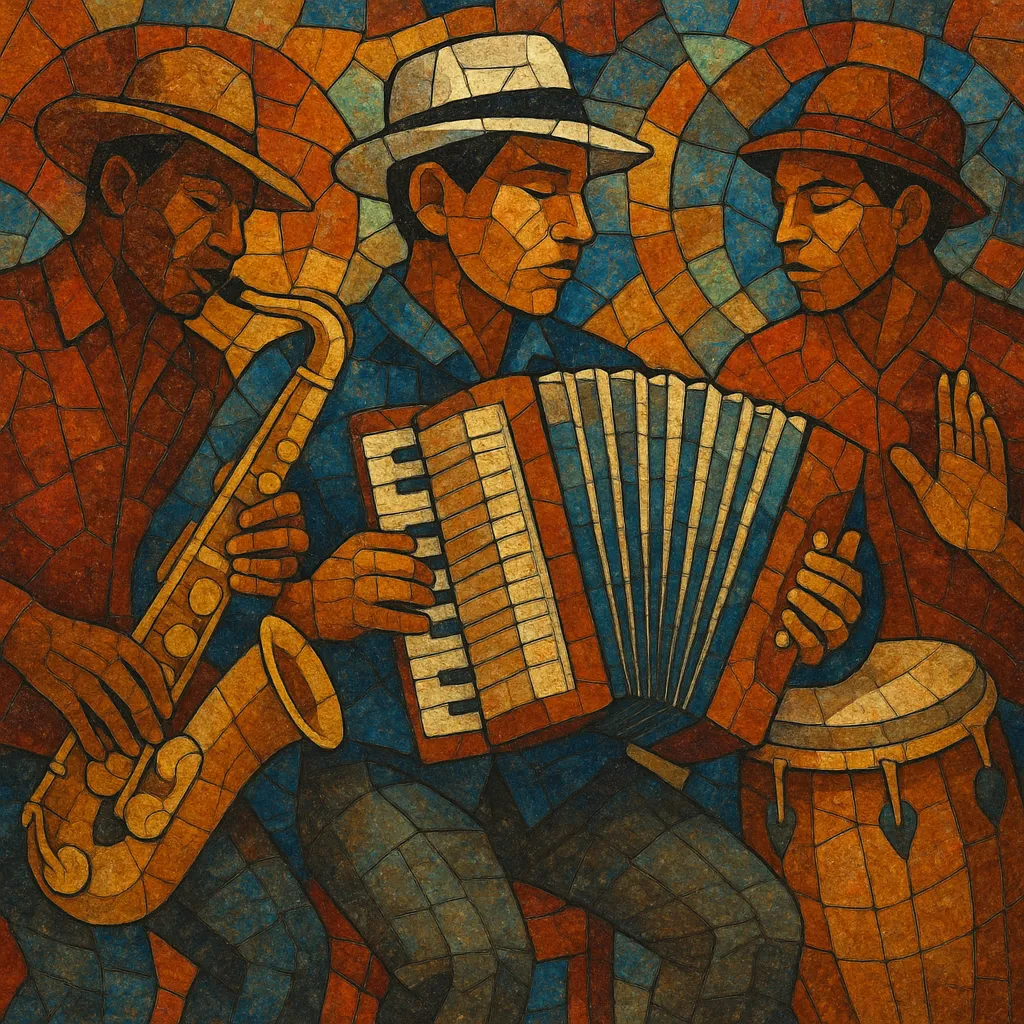Merengue is a fast, dance-centered popular music from the Dominican Republic characterized by a driving 2/4 meter, bright major-key harmonies, and a propulsive rhythmic engine created by güira and tambora. In its rural "típico" form, the lead instrument is a diatonic accordion, supported by tambora, güira, and bass.
Urban and orchestral evolutions expanded the instrumentation to include saxophones, trumpets, trombones, piano, congas, and electric bass, yielding a powerful big-band sound. Common song forms use verse–chorus structures with catchy coros and a climactic jaleo section where horns or accordion play tightly arranged riffs. The style spans energetic party anthems, romantic ballad-leaning numbers (merengue romántico), and modern fusions that blend with pop and urban music.
Merengue emerged in the Dominican Republic in the mid-19th century, drawing on European couple-dance forms (such as the contredanse and polka) and Afro-Caribbean rhythmic practices. Its early rural version—today called merengue típico or perico ripiao—featured accordion, tambora, and güira, and quickly became an emblematic social dance.
By the early 1900s, merengue was widespread in the Cibao region. Cross-island currents with Haiti (whose related méringue tradition is closely connected) and pan-Caribbean influences (including Cuban habanera and son) informed repertoire, dance figures, and ornamentation. The music remained primarily rural but was poised for national prominence.
Under Rafael Trujillo’s regime, merengue was promoted as a national symbol, moving from countryside festivities into formal ballrooms. Ensembles added piano, saxophones, trumpets, and bass, adopting big-band arranging techniques and swing-era polish, while keeping the genre’s hallmark 2/4 drive.
From the 1970s onward, artists and bandleaders modernized merengue’s sound, integrating electric instruments, jazz-influenced harmonies, and sophisticated horn charts. The 1980s–1990s marked a global boom, with merengue becoming a staple of Latin pop and dance floors across the Americas and Europe. The era also saw the rise of merengue romántico alongside high-energy party anthems.
In the 2000s, producers and bands experimented with electronic timbres and urban aesthetics, spawning substyles like tecnomerengue and merenhouse, and influencing Dominican mambo urbano. While contemporary pop and urban styles have competed for airtime, merengue remains a cornerstone of Dominican musical identity and a durable pillar of tropical music internationally.
Write in a brisk 2/4 meter, typically 140–180 BPM for dance-floor energy. Anchor the groove with the güira playing steady sixteenth notes and accents, and the tambora executing characteristic two-hand patterns (alternating bass-drum strokes and rimshots). Keep the groove relentless and forward-driving.
For típico: feature a diatonic accordion as the lead voice, with tambora, güira, and bass (electric or acoustic). For orquesta: add saxophones (often in section), trumpets, trombones, piano, congas, and sometimes guitar. Reserve space for a jaleo section where horns or accordion deliver call-and-response riffs and fast runs.
Use bright major keys and simple, catchy progressions (I–IV–V and their relative minors). In pop-oriented arrangements, incorporate ii–V turnarounds and secondary dominants for lift. Structure songs as verse–prechorus–chorus with short coros, then build to a horn or accordion jaleo. Modulating up a whole step late in the song adds excitement.
Write a two-beat bass pattern emphasizing root–fifth motion and anticipations on the “and” of beat 2. Craft piano or accordion guajeos: syncopated, arpeggiated ostinati that lock with the güira. For horns, arrange tight unison or close-voiced riffs (mambos) that punctuate the groove; intersperse call-and-response between coros and horn lines.
Aim for memorable, chantable choruses with coros that dancers can sing along to. Verses can be flirtatious, humorous, topical, or romantic. Maintain clear phrasing aligned with the two-beat feel, and consider brief breakdowns to spotlight güira and tambora before the final jaleo.
Capture the metallic texture of the güira and the punch of the tambora prominently in the mix. In modern fusions (tecnomerengue or merenhouse), layer electronic kick and claps with the acoustic percussion, sidechain pads and synths to the rhythm, and retain horn or accordion hooks to preserve the genre’s identity.


